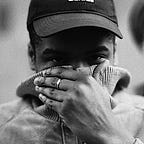For better or for worse — the changing landscape of film
The last year has changed the way the film industry works — and that’s okay! Producer Efosa Osaghae explores why.
Everyone’s pretty tired of hearing about COVID-19 by now — I know I am.
We’ve heard a lot about how the ongoing situation is negatively effecting the creative industries, with productions grinding to a halt and many freelancers out of work.
But a year on, there some signifiant cultural shifts within the film industry that I’d like to see continue when this chapter concludes — a silver lining for the film industry.
Communication
The first, and the most drastic, shift we’ve seen is in communication. The line of contact between production, talent, and the client is crucial and the pandemic has changed the dynamic forever.
Let’s imagine you’re a producer. It’s 2019. You’re planning a shoot next week. How would communication be conducted?
- Several phone calls and emails between prospective cast and crew.
- Meeting the shortlisted crew candidates to make the final choice.
- Organising auditions with a casting director for your key cast to get a feel of their ability in person.
- Finally, meeting everyone again, in person for either a table read or initial briefing before the madness of a shoot begins.
That same producer in 2021? They’re working in a very different way.
- All auditions and job interviews conducted via Zoom or phone call
- A meeting can now be a WhatsApp or Email conversation
The benefits? No more time and money is being wasted while selecting your team. Although perhaps not as in-depth as an in person meeting, the convenience of setting up a call vs an in person meeting is hard to deny.
Ever been in a meeting and thought, ‘this could have been an email’? We’re living in that alternative reality. Why waste an hour on something that can be discussed in 5 minutes? Most meetings are professional formalities to appease tradition. In the film world, where everything moves at break neck speed, any time you can save is invaluable.
Location
In 2019, in order to scout the right location, it wouldn’t be uncommon for myself and a large team to all venture out on the recce.
Director. Cinematographer. First AD. Production Manager. Locations Manager. Art director. Art director assistant. Gaffer. Spark. Producer’s Assistant — I’m sure I’m missing a few.
Looking back, all I can think is, why?
Today, following various government and industry guidelines, these trips are a maximum of 5 people. In paring down such trips, it is clear that there is simply no need to travel to locations with an entourage. With hindsight, a smaller group becomes the obvious choice. When you have up to ten other people behind you staring like hawks, negotiation and rapport building with the location owner can be far more difficult than it needs to be.
Having fewer people is also advantageous in that you keep the conversation flowing between the key crew members — all the relevant infomration can be passed down to other team members with ease (via an on location Zoom call, if necessary), without them needing to be on location.
Time? Saved.
Money? Saved.
On Set
On set, the biggest apparent difference is heightened precision from the director and creative team. At the best of times, a production is stressful and time is a luxury that is perpetually slipping away.
However, due to most productions undergoing rapid on-site COVID testing, shooting days are being condensed like never before. What was once a 12 hour day just became a 10 hour day, meaning that directors, producers, and the crew as a whole needs to make the most out of every second.
Gone are the days where you could just wing it and hope for the best.
Every crew member must know what’s at stake, otherwise you can expect a project to accrue nasty overtime costs. If you still wanted to go the ‘winging it’ route, you should add 10% to the budget to account for this.
Clients are typically not covering any sort of ‘COVID’ contingency so the key is precision, precision, precision.
What does the future hold?
Along with job security as the situation stabilises, hopefully we can look forward to more of the same in regards to streamlining the entire production process to increase time, and savings. I want to see more precision from creative teams, and also clients willing to cover looser structured productions.
There are, of course, many aspects of production I want to return to normal. It’s a lengthy and pretty self-explanatory list, which has been explored by filmmakers all over the world for months. This is why its helpful to mention the lesser discussed production elements that we should look at keeping in place.
After all, we should all be thankful that the film industry can continue and, in turn, productions should be creatively finding ways to improve productivity while adhering to the protocols.
